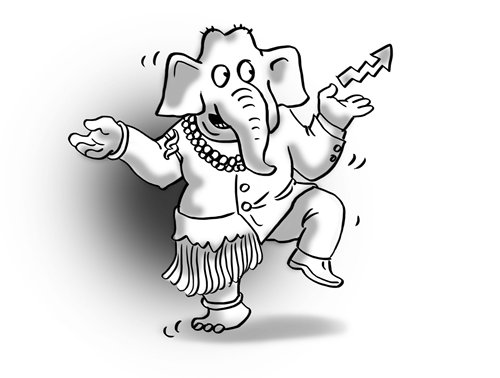Unity of contrasts lends character to India

Illustration: Liu Rui/GT
Landing at the Indira Gandhi International Airport in New Delhi, what first reminds you of where you are is the sign on the restrooms on one side of the corridor - the portraits of a young man on the left and a young woman on the right. The handsome man wears a traditional turban woven in red and green cloth with golden designs. The charming Indian woman wears delicate jewelry and a golden sari. They welcome visitors from all over the world with a beautiful smile.Going down the escalator to the Customs hall, one can see a huge poster with "World's No.1 airport" on it. No one would bother to think how and when it gained the reputation. But assured by the bright, spacious and modern hall, every foreigner would believe the airport deserves such eminence.
The counters for immigration control are set up under a large decorated wall. Nine giant Buddhist hands jut from hundreds of copper discs with different auspicious Hindu gestures. A delicately crafted lotus design can be seen at the center of each palm.
A brief stay at the Indira Gandhi International Airport left a deep impression on me, especially the wall with hands adorned as Buddhist motifs representing Indian religious ethos with a delicate touch.
During my following trip, I kept vacillating between modernity and tradition, religion and secularism, cleanliness and squalor, and sophistication and vulgarity.
For some Chinese, India seems to have nothing to do with words like delicacy. Filth and disorder overshadow the image of India, but that is not all about the country. The Indira Gandhi International Airport instantly makes you think of advanced "Made in India" products such as software, rockets and the Mars orbiter.
Another place is the Akshardham Temple in suburban Delhi. The complex is the biggest Hindu temple and displays millennia of Hindu delicacy. It is not only a perfect project, but also a reminder of the Indian speed. It took 3,000 volunteers and 7,000 artisans only five years to build the world's biggest Hindu shrine complex. Since its opening in 2005, it has become a must-see for foreign travelers.
The design of the temple embodies perfection with magnificent and exquisite workmanship. Beside the main temple is the pavilions gallery made of red sandstone, surrounded by lush gardens. In the main building are thousands of fine sculptures of birds, animals and divinities. Everywhere you come across precise craftsmanship and divine cleanliness.
Bare feet on the white marble, one can feel cool even though the mercury has climbed to 40 C. Seeing me stare at the marble slab, a volunteer came to me and said, "The marble was from northern India and feels warm in winter and cool in summer."
Roughness and carelessness do not belong to this temple. I suddenly realized why this country, where people pee against the wall on the street, has delicate governing and manufacturing capabilities. Indians can consume a couple of years just for a power plant project, but they can also build such a majestic temple in only five years.
The unity of opposites is the most prominent feature of the country. Completely different things can co-exist harmoniously. It differs from China in the way that you can't believe you are in the same country when encountering such contrasts.
In China, there is always a transition between two completely different things, while what India lacks is something in the middle.
The author is a senior editor with the People's Daily, and currently a senior fellow with the Chongyang Institute for Financial Studies at Renmin University of China. dinggang@globaltimes.com.cn. Follow him on Twitter @dinggangchina

